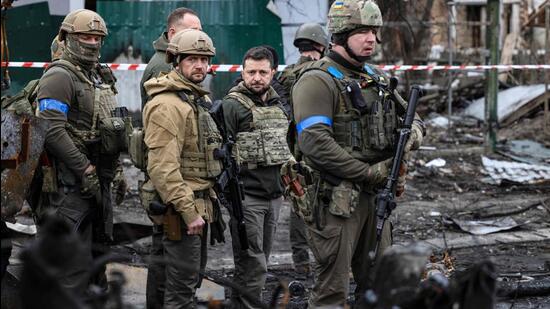The year ahead: A spring of hope and fear
As a dreaded virus rears its head, a war threatens order in the world, and inflation looms, countries are turning inward, shoring up reserves with a wary eye on their neighbours. By the end of Spring, we’ll know whether we are headed into a summer of discontent
The sounds of spring will tell us what sort of year India and the world can expect. If three major developments come together in the right mix, April showers will bring May flowers; if not, it will just be 2022 with nastier knobs on.

The most obvious question is whether Russia and Ukraine will begin to jaw-jaw rather than war-war. The other trend will be less exciting but just as momentous: the interest rate decisions of the United States central bank chairman, Jerome Powell. If he continues to ride full tilt at inflation into the spring, Powell could drag the US economy, and therefore the world economy, into recession. Finally, with China having a fresh bout of runaway Covid-19, the fingers-crossed hope is that the wave there will burn itself out by April.
Russia and Ukraine are going to celebrate the new year with winter offensives. Russia has new ranks of conscripts, Ukraine has new American weapons; both have new tactics. Vladimir Putin and Volodymyr Zelensky are politically bound to let slip their armies a few more times. The question is, when will both accept they have reached a stage of the war where men and machines are being ground up for less and less on the ground. German intelligence has told its legislators it expects the war to start winding down by spring.
Similarly, the business world is waiting for the day when Powell will indicate that he believes he has slain the dragon of inflation. The world emerged from pandemic lockdowns last year flush with funds and predictions of global growth at rates of 4% to 5%. Then Ukraine was invaded. A war premium was added to existing price pressures caused by chronic underinvestment in new fossil-fuel sources and climate-related food shortfalls. Prices took off, Powell was caught napping, and he has been the grim reaper of monetary policy since, to compensate. No one is sure when he will take his foot off the brake, but the earliest would be the second calendar quarter.
Meanwhile, in China, there are only guestimates of what is going on. Leaked numbers suggest that 250 million have already been infected in this wave, indicating that the virus is racing through the population at warp speed. Some models indicate it will all be over by spring. Some of the models indicate that millions could die.
That’s not even the worst-case scenario. The worst unknown known would be for the millions of Chinese cases to generate new and deadlier variants of Covid-19.
At the same time, the Russian war in Ukraine could be stepped up a notch, especially if one side suddenly makes progress, has a sniff of victory and scuppers any chance of diplomacy. This would rev up the inflation engine, with the exhaust producing more US interest-rate hikes and another dollar rally.
The problem is how much all this is up in the air. Which is why many governments, with India at the forefront, are raising drawbridges and stocking up their pantries. India has spent billions on fertiliser subsidies and has busily been shoring up grain reserves. It has done the same, though less successfully, with coal stocks and energy supplies. It is trying to increase rupee trade, not out of pride but with the idea of preserving its dollars. India went into Christmas with Covid-19 drills and buzz about masks and boosters. There was no wailing of sirens, but a fair amount of Keep Quiet and Carry On Hoarding.
New Delhi is also nervous about the impact on its neighbours. Bangladesh, the Maldives, and Pakistan all go to the polls next year. They are all under storm and stress as their economies struggle to survive high fuel prices, shrinking reserves and plummeting currencies. Two of the three have India-friendly governments which New Delhi would like to return to power. Sri Lanka is also touch-and-go: it enters the new year with an effective foreign exchange reserve of about $200 million. Having seen much of the goodwill and influence won -- and bought -- by China in this neighbourhood evaporate in 2022, India will have to work to ensure that all its recent gains are not lost beneath of a new wave of economic distress.
A core aspect of India’s strength comes from the fact that, at a time when the global ecosystem is changing — capital is no longer cheap, governments no longer buy weapons to never use them, safe and secure supply chains are supplanting talk of free trade — New Delhi has retooled the economy to make it more resilient to change. If the world becomes a bit less of a roller-coaster by summer, the benefits will become evident. If the world U-turns down a dark tunnel, India will at least be buffered.
(Pramit Pal Chaudhuri is South Asia practice head at Eurasia Group and former foreign editor, Hindustan Times)





